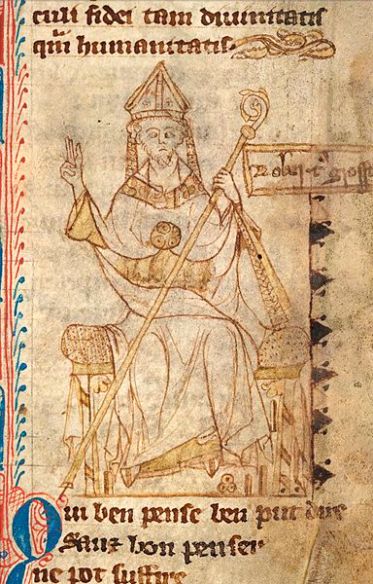When reading the lives of medieval saint-bishops, in which depictions of emotional extremes often figure prominently, it is easy to feel that Johann Huizinga’s claims about ‘the unrestrained extravagance of the medieval heart’[1] were perhaps not so far from the truth after all. Consequently, I have now started to look for occasions when emotions were reined in, and emotional behaviours which were generally frowned upon.
For medieval bishops, one forbidden emotion was self-pity. Whilst the vitae of the English saint-bishops of the twelfth and thirteenth centuries are generally tear-sodden affairs, tears of self-pity are conspicuously absent. An extract from the Life of St Richard of Chichester illustrates the correct response to personal misfortune:
When they told him that a fire had caused great destruction to his houses and property, his household grieved and wept, but he wore a serene expression and cheerful aspect and thanked God and comforted those in distress saying ‘Do not be said. We still have sufficient to provide you with clothing and other necessities.’ And he added, ‘These things have happened because we have not given alms as generously as we should. Therefore we wish and command that we provide more lavish alms in future.’ [2]
Whilst his household was overwhelmed by fear and loss, the saint knows that it is not appropriate to weep. Instead, he is calm and rational. He understands that this misfortune is a lesson from God, considers what they had done to displease Him, and identifies a solution which will restore them to divine favour.
But, human nature being what it is, it would be very surprising if medieval bishops never felt sorry for themselves- and there are a handful of stories in which a bishop indulges in self-pity. Perhaps the most striking is Henry of Huntingdon’s recollection of how Robert Bloet, bishop of Lincoln (1094-1123), wept one night at dinner. When asked the reason for his tears
He said ‘In the old days those who waited on my were dressed in costly apparel. Now, because of the fines imposed by the king, whose pleasure I have always been most diligent to serve, they have to be clothed in woollens.’ He felt such despair about the king’s friendship that when he was told that the king, in his absence, had spoken high praise of him, he sighed and said ‘The king only praises one of his men when he has decided to destroy him utterly.’ [3]
Bloet was a stereotypical courtier-bishop whose priority (at least until he fell out of favour with Henry I) was undoubtedly royal service. But in Henry of Huntingdon’s hands, this is more than just a critique of a bad bishop. Bloet was, he says, a good man, ‘meek and humble, building up many and pulling down no one, the father of the fatherless, the delight of his men.’ His fatal weakness was his loyalty to the king, which turned him into a ‘worldly man.’ According to Henry of Huntingdon, such men ‘usually meet bitter misfortunes before death.’ Indeed, Bloet’s death itself demonstrated the dangers of putting too much faith in the King, and too little faith in God. A few days later after the aforementioned dinner, Bloet was at a hunting party at Woodstock, in the company of the king, when he suffered a stroke.
Still alive, but speechless, he was carried into his lodgings and shortly afterwards, while the king was with him, he died. The great king whom he had always served, whom he had greatly loved and feared, whom he had regarded so highly, and in whom he had placed such confidence, could give no more help to the poor man in his greatest need.[4]
There was very little danger than Robert Bloet would ever be considered as a possible saint, yet his story was not without value: the reader could learn from the mistakes of this fallible human being just as he could profit from the exemplary conduct of the saint-bishop. And in both of these stories, the depiction of emotional behaviours is central to their power. We know that Richard Wyche is a saint because, confronted by disaster, his response is different to that of his household; his emotions set him apart from the rest of humanity. On the other hand, the power of Robert Bloet’s story derives from his very humanity, as reflected in his tears. The reader who fails to learn from the failings of this man will come to share his sorrow.
[1] J. Huizinga, The Autumn of the Middle Ages (Chicago, 1997), p. 15.
[2] Saint Richard of Chichester: The sources for his life, ed. D. Jones (Lewes, 1995), p. 115 (with translation at p. 191).
[3] Henry, Archdeacon of Huntingdon: Historia Anglorum, ed. D. Greenway (Oxford, 1996), pp. 586-89.
[4] Historia Anglorum, pp. 588-89.

